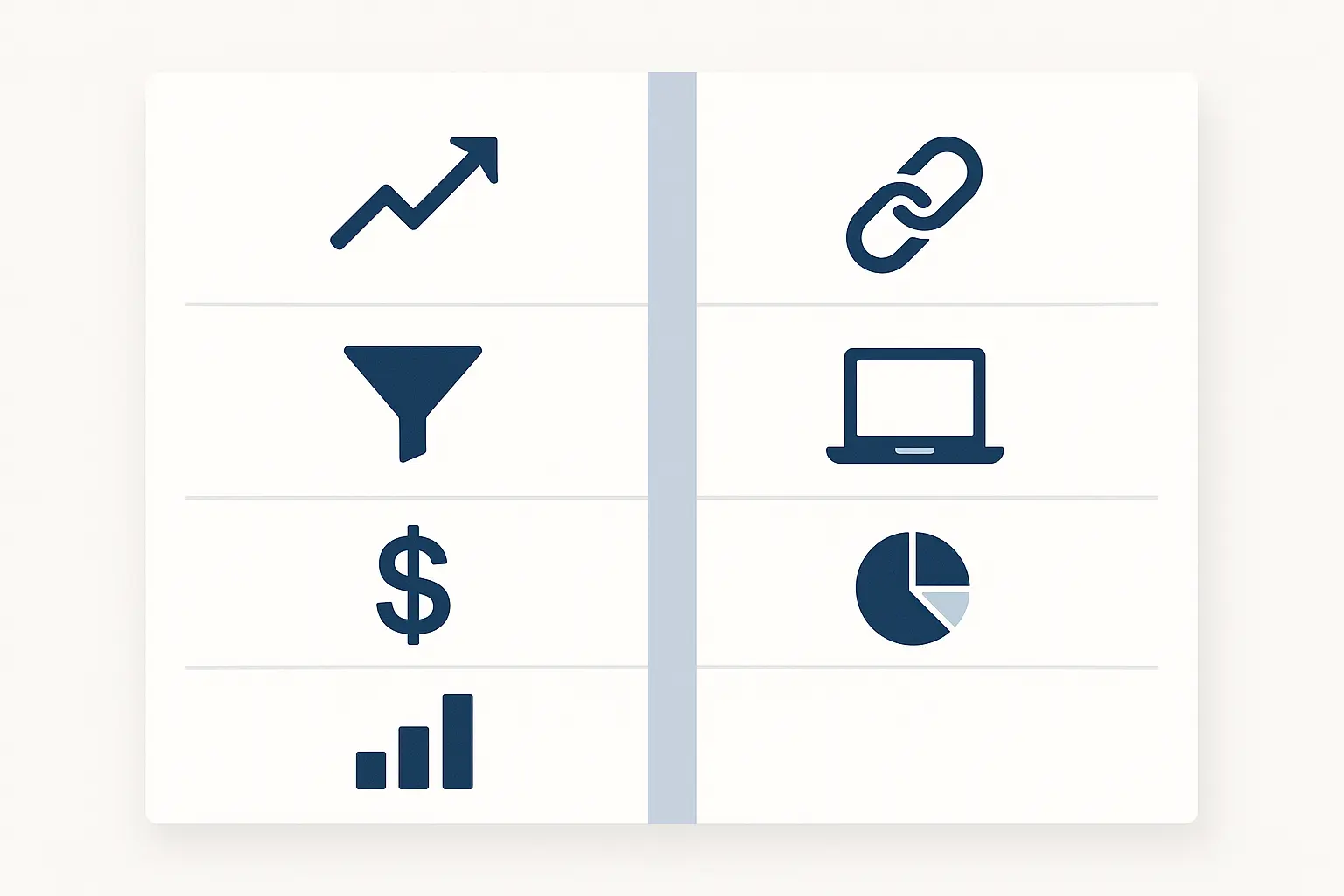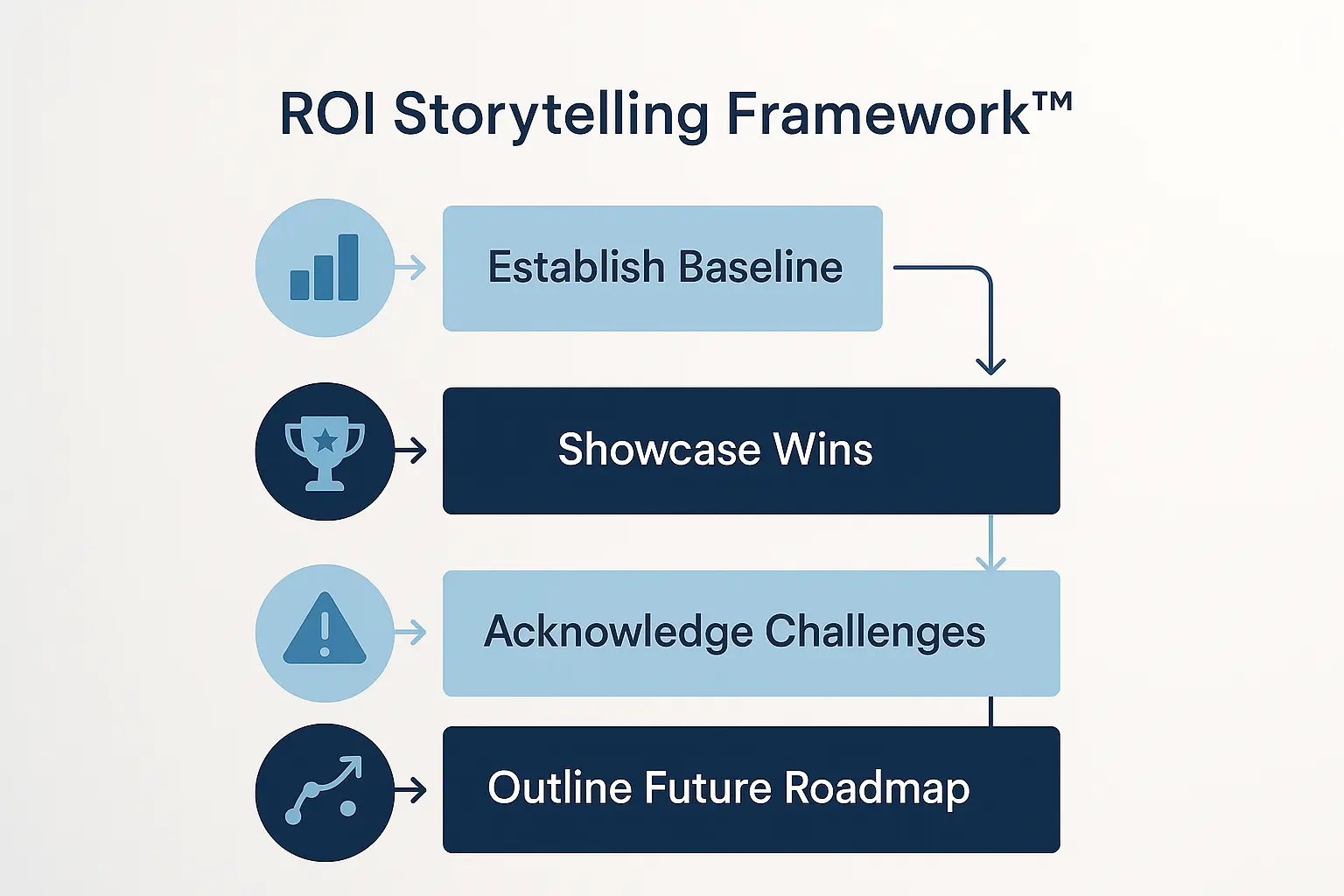You delivered the monthly SEO report. It’s packed with green arrows: rankings up, traffic climbing, backlinks secured. But across the Zoom call, your client looks unconvinced. They ask the question that quietly dismantles agency-client relationships every day: “This is great, but how is it helping my business grow?”
This is the silent killer of agency growth. It’s not a lack of results, but a failure to connect those results to what clients value most: revenue, leads, and market share.
Most SEO reporting guides and tools miss this point entirely. They offer endless lists of metrics and dashboard widgets, but they don’t provide a framework for communication. They teach you what to report, but not how to tell a story that justifies your retainer and secures your renewal.
This guide is different. We’re moving beyond tool-centric listicles to give you a strategic playbook for demonstrating value. You’ll learn how to speak the language of the C-Suite, build a narrative that connects your work to their bottom line, and transform your reports from a monthly obligation into your most powerful retention tool.
Beyond Rankings: Speaking the Language of the C-Suite
The first mistake agencies make is assuming clients care about the same metrics they do. While keyword rankings and domain authority are crucial indicators for an SEO professional, they are just noise to a CEO or CFO. To them, SEO is an investment, and they measure investments by one thing: its return.
Executives consistently prioritize metrics tied directly to business outcomes. While you’re focused on the mechanics of search, they’re looking at the big picture. To build trust and prove your worth, you need to shift your reporting focus from tactical outputs to strategic outcomes.
Here’s how to translate standard SEO metrics into the language of the C-Suite:
Instead of Keyword Rankings, focus on Share of Voice and Market Visibility. This shows how you’re dominating competitors for business-critical topics, not just individual keywords.
Instead of Organic Traffic, focus on Qualified Lead Generation. This connects traffic increases directly to the number of sales-ready leads entering their pipeline.
Instead of Backlink Count, focus on Referral Revenue and Brand Authority. This positions link building as a driver of direct traffic and revenue, not just an SEO signal.
Instead of Time on Page, focus on Conversion Rate from Organic Search. This demonstrates that the traffic you’re driving is engaged and taking valuable actions.
Instead of Impressions, focus on Revenue Attributable to Organic Search. This is the ultimate metric. It answers the “so what?” by putting a dollar value on your efforts.
Instead of Domain Authority, focus on a Lower Customer Acquisition Cost (CAC). This shows that SEO is a more efficient and profitable growth channel compared to paid advertising.
When you start reporting on attributable revenue and lead-to-customer rates, you fundamentally change the conversation. You’re no longer just “the SEO agency”; you’re a strategic growth partner, making it much easier to justify your value. With an average SEO ROI of over 800% across industries, the data is on your side—you just need to present it correctly.

The ROI Storytelling Framework: From Data Points to Business Narrative
Data alone doesn’t convince; stories do. A great report isn’t a spreadsheet of numbers—it’s a compelling narrative that guides your client through the journey of their investment. It builds confidence, manages expectations, and reinforces the value of your partnership.
We call this The ROI Storytelling Framework. It’s a simple, four-part structure for turning your data into a story of progress and partnership each month.
Step 1: Establish the Baseline (Where We Started)
Always begin by reminding the client of the starting point. Use simple visuals to show key metrics from last month or the previous quarter. This context is crucial for demonstrating progress and anchoring the value of the results you’re about to present.
Narrative Cue: “As a reminder, when we started this quarter, our organic lead volume was at X, and our primary competitor held 30% more market share for our target topics. Let’s look at where we are now.”
Step 2: Showcase the Wins (Connecting Activity to Impact)
This is the core of your report. Present your key successes, but always tie them back to a C-Suite KPI. Don’t just say, “We increased blog traffic by 50%.” Instead, say, “Our new content strategy increased blog traffic by 50%, generating 22 new qualified leads and influencing $15,000 in the sales pipeline.” This direct connection makes your value undeniable and is a key part of any successful suite of white-label SEO services.
Narrative Cue: “The technical site optimizations we completed last month directly resulted in a 1.2-second improvement in page load speed. As a result, our organic conversion rate increased from 2.1% to 2.8%, adding an estimated $25,000 in e-commerce revenue.”
Step 3: Acknowledge the Challenges (Building Trust Through Transparency)
No campaign is perfect. Transparency about challenges or dips in performance builds immense trust. Address any red arrows head-on, explain why it happened (e.g., a Google algorithm update, a competitor’s campaign), and detail your plan to address it. This positions you as a proactive, strategic problem-solver, not just a service provider.
Narrative Cue: “You’ll notice a slight dip in rankings for our secondary keyword group. This is due to a recent Google update that impacted the entire industry. We’ve already analyzed the changes and are implementing a content update strategy to regain those positions over the next 30–45 days.”
Step 4: Outline the Future (The Strategic Roadmap)
End the meeting by looking forward. Briefly outline your strategic priorities for the next month or quarter and connect your upcoming activities to the client’s overarching business goals. This shows you have a long-term plan and reinforces that your partnership is an ongoing journey toward growth.
Narrative Cue: “Building on our content success, next quarter we will focus on an omnichannel SEO strategy to amplify our message across social channels, which we project will increase lead velocity by another 15%.”
Building Your White-Label SEO Dashboard: The Engine of Your ROI Story
Your report’s design should be as professional as its content. A clean, branded, and intuitive white-label dashboard is crucial. It serves as the visual anchor for your ROI story, making complex data easy for clients to understand at a glance.
A generic report from a third-party tool can subtly undermine your authority. When every deliverable—from the initial audit to the monthly report—is under your brand, you solidify your position as the single source of truth and expertise.
Key Elements of a High-Impact White-Label Dashboard:
-
Executive Summary on Top: Start with the 3-4 key KPIs that matter most to the C-Suite (e.g., Organic Revenue, Qualified Leads, CAC). A busy executive should be able to grasp the core results in the first 10 seconds.
-
Goal Pacing Visuals: Don’t just show current numbers; show them in the context of the goals you set together. A simple progress bar showing “75% to Quarterly Lead Goal” is more powerful than a standalone number.
-
Trended Performance Graphs: Use line charts to show performance over time (3, 6, or 12 months). This smooths out monthly fluctuations and highlights the long-term upward trajectory of your strategy.
-
Channel Comparison: Include a simple pie or bar chart that compares the performance of organic search against other channels like paid search or social. This is a perfect opportunity to highlight the superior ROI and efficiency of SEO.
-
Annotations and Insights: Don’t just present a graph; add a small text box explaining what it means. For example, next to a traffic spike, add a note: “Spike from launch of ‘Ultimate Guide’ content asset on May 15th.” This connects your actions to the results.
-
Your Branding, Front and Center: Your logo, your colors, your voice. The report should look and feel like it was built from the ground up by your team, reinforcing your agency’s brand and value. This is where AI-powered SEO automation becomes a game-changer, handling the data crunching so you can focus on the branding and narrative.

From Report to Relationship: Mastering Client Communication
The final piece of the puzzle is your delivery. The best report in the world is useless if it isn’t presented with confidence and clarity. The monthly reporting call is your single best opportunity to reinforce your value and strengthen the client relationship.
Tips for a Killer Reporting Call:
-
Lead with the Bottom Line: Start the meeting with the single most important business result you achieved. “Good news—organic search influenced over $50,000 in new sales pipeline this month. Let me walk you through how we did it.”
-
Guide, Don’t Read: Use your dashboard as a visual aid, not a script. Speak to the key insights and tell the story behind the data. Keep the focus on the “why” and “so what.”
-
Turn Questions into Opportunities: When a client asks a question, see it as a chance to educate them and reinforce your expertise. If they ask why a metric is down, use your ROI Storytelling Framework to explain the context and your plan.
-
Keep it Concise: Respect their time. A well-structured, 20-30 minute call that focuses on business impact is far more effective than a 60-minute slog through every keyword ranking change.
-
End with an Action Plan: Conclude the meeting by summarizing the key takeaways and agreeing on the next steps for both your team and theirs. This creates accountability and momentum.

The Partner That Powers Your Proof
Shifting your reporting from tactical updates to strategic business reviews is the single most effective way to reduce churn, justify your fees, and grow your agency. It’s the difference between being seen as a vendor and being valued as an indispensable partner.
But doing this consistently and at scale is challenging. It requires a seamless blend of powerful execution, automated data aggregation, and a strategic client-facing wrapper. This is where many agencies struggle—they’re so busy with day-to-day execution that they lack the bandwidth to build a scalable, high-impact reporting and communication system.
JVGLABS was built to solve this exact problem. We are the white-label SEO partner that operates invisibly in the background, powering your execution with up to 90% AI-driven automation. But we don’t just stop at execution. Our platform provides the fully white-labeled dashboards and C-Suite-ready reporting frameworks you need to prove your value effortlessly.
We handle the execution. You own the strategy and the client relationship. Together, we help you deliver—and demonstrate—unbeatable results.
Ready to stop defending your retainer and start proving your ROI? Explore how JVGLABS can become the invisible SEO department that powers your agency’s growth.

Frequently Asked Questions
-
How do I handle a situation where SEO results and rankings have temporarily dropped?
Use the “Acknowledge the Challenges” step of the ROI Storytelling Framework. Be proactive and transparent. Explain the likely cause (e.g., algorithm update, competitor activity, technical issue) and present a clear, confident action plan to address it. Your honesty and strategic response will build more trust than a perfect report ever could. -
My clients are not data-savvy. How can I simplify the report even further?
Focus on a single, primary KPI that they care about most, whether it’s demo requests, online sales, or qualified phone calls. Make that the hero metric of your report. Use simple analogies to explain complex topics. For example, think of technical SEO as “tuning up your website’s engine so it can go faster and win the race.” -
How long should it take to demonstrate a clear ROI from SEO?
Setting realistic expectations from the start is crucial. While foundational improvements can show results in 3-4 months, a significant, revenue-driving impact typically takes 6-12 months. Your reporting should track leading indicators (e.g., ranking improvements, traffic to key pages) along the way to show progress toward the ultimate goal of ROI. -
How is using a white-label partner different from just buying a reporting tool like AgencyAnalytics?
Reporting tools are just one piece of the puzzle—they provide the “what” (the data and charts). A true white-label partner like JVGLABS provides the “how” and the “who.” We are the execution engine behind the data, using an omnichannel growth SEO approach to deliver the results. Our platform then provides the reporting infrastructure you need to communicate that value. It’s an end-to-end solution that helps agencies scale SEO profitably, without the operational overhead.

